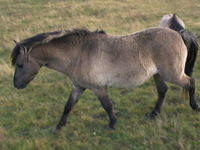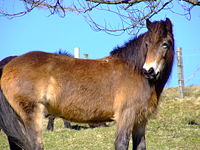| Home | First Posted: Jan 10,2008 Jan 21, 2020 | |
Wild or Feral Horse?Wild horse
"Today, wild horses are found only in parts of Africa and Asia. They are classified into four main groups within the genus Equus: ASL Living Conservation
Asiatic Wild Asses African Wild Asses Caballine (True) Horses Zebras 'Bred back' Tarpan in Haselünne, Germany (2004) The Wild Horse (Equus ferus or Equus ferus caballus) is a member of the Horse genus which currently is native only in Asia. The true wild horse is not merely a feral horse like the Mustang; a true wild horse species is one which was never successfully domesticated. 
Two species or subspecies (taxonomy is debated) of wild horses survived into modern times: The Tarpan or Eurasian Wild Horse (Equus ferus ferus), once native to Europe and Asia, and the Przewalski's's Horse or Mongolian Wild Horse The Przewalski has notable biological differences from the domestic horse; unlike domesticated horses, which have 64 chromosomes, the wild horse has 66 chromosomes. However, the offspring of Przewalski and domestic horses are fertile, possessing 65 chromosomes. Other species of wild horses were once indigenous to North America, as well, populating the continent before and during the last Ice Age. Approximately 10,000 years ago, some horses in the Western Hemisphere migrated to Eurasia across the Bering land bridge, and fanned out from Siberia to the rest of Asia, Europe, and the Middle East. What horses remained behind became extinct in North America. There are several competing theories about why this happened. One theory holds that climate changes associated with the end of the last Ice Age caused the extinction of the horse, the mammoth and other large land animals. Another theory holds that newly-arrived humans hunted horses to extinction. A third holds that the newly arrived humans brought a biological factor which caused the demise of horses and other large ungulates in the Americas. It is also possible that it was a combination of factors. History
Only two never-domesticated "wild" groups survived into historic times, Przewalski's horse, or Equus ferus przewalski, and the Tarpan, or Equus ferus ferus Przewalski's horse occupied the eastern Eurasian steppes, perhaps from the Urals to Mongolia, although the ancient border between Tarpan and Przewalksi distributions has not been clearly defined. The Tarpan became extinct in the late 19th century. Przewalski's horse was limited to Dzungaria and western Mongolia in the same period, became extinct in the wild during the 1960s, but was re-introduced in the late 1980s to two preserves in Mongolia. Although researchers such as Marija Gimbutas theorized that the horses of the Chalcolithic period were Przewalski's, more recent genetic studies indicate that Przewalski's horse is not an ancestor to modern domesticated horses. However, other subspecies of Equus ferus, may have existed and could have been the stock from which domesticated horses are descended. Taxonomy
While taxonomy is debated, one view is that the wild horse and domestic horse belong to the same species. Thus, to conform to the Code of the International Commission of Zoological Nomenclature the scientific name of the wild horse Equus ferus was discontinued by Wilson and Reeder in 1993 and wild horses were added to Equus caballus, the name given by Linnaeus. Some scientists criticized this change of the scientific name, arguing in favor of a distinction between wild and feral or domesticated animals. As a result, in 2003, the International Commission on Zoological Nomenclature "conserved the usage of 17 specific names based on wild species, which are pre-dated by or contemporary with those based on domestic forms," re-confirming Equus ferus for the wild horse. Taxonomists who consider the domestic horse a subspecies of the wild horse should use Equus ferus caballus but the name Equus caballus remains available for the domestic horse where it is considered to be a separate species. Feral Horses
Feral horse in the Pentland Hills, Scotland. Feral horses, though popularly called "wild" horses, are not truly wild; their ancestors were domesticated animals. 
Feral Horse and Mustang (horse)
Horses which live in an untamed state but have ancestors who have been domesticated are not true "wild"horses; they are feral horses. The best known examples of feral horses are the "wild" horses of the American west. When Europeans reintroduced the horse to the Americas, beginning with the arrival of the Conquistadors in the 15th century, some horses escaped and formed feral herds known today as Mustangs. The Australian equivalent to the mustang is the brumby, descendants of the horses let loose in Australia by English settlers. In Spain, the free-ranging feral horse is known as Sorraia. There are also isolated populations of feral horses in a number of places, including Sable Island off the coast of Nova Scotia, and Assateague Island off the coast of Virginia. Some of these horses are said to be the descendants of horses who managed to swim to land when they were shipwrecked. Others may have been deliberately brought to various islands by settlers and either left to reproduce freely, or abandoned when assorted human settlements failed. While these are often referred to as "wild" horses, they are not truly "wild" in the biological sense of having no domesticated ancestors. Prezewalski's and Przewalski's horse are both correct spellings. Modern Feral HorsesDonkeys aka Ass, Equus Africanus Asinus, Equus Asinus-Used Around the World Donkey vs. Horses in Pain |